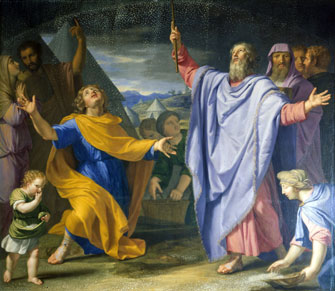Heavens Above! Painting
Religion in the 17th Century

“La Manne dans le Désert,” by Jean-Baptiste de Champaigne, from the Èglise Saint-Etienne-du-Mont in Paris. © COARC/Roger-Viollet
The French Revolution may have helped launch the Republic and open the way to modern democracy, but it caused untold damage to the churches of France. It is a sobering reminder to see at the beginning of this excellent exhibition a map of 17th-century Paris featuring the large proportion of churches that no longer exist. Not only were churches destroyed, but much of the artwork within them was ruined or pillaged. Now the Musée Carnavalet, which houses a permanent collection on the history of Paris (well worth a visit on its own terms), is showing 89 paintings that either survived the destruction or still hang in the city’s churches in the exhibition “Les Couleurs du Ciel” (“The Colors of Heaven”).
The show is divided into four main sections corresponding to four periods: 1585-1630, when spiritual renewal and an artistic transition followed the Wars of Religion; 1630-50, described as a golden age of religious painting under Louis XIII, who dedicated his kingdom to the Virgin Mary in 1638; 1660-80, when religious painting flourished under Louis XIV’s personal rule; and 1680-1715, the final years of Louis’s reign, after many of the great painters of the age had died. As useful as the accompanying commentary is, visitors should be warned that it is only in French.
Of the many glories that this exhibition contains, the great painters of the time are well represented, but many lesser-known artists are also given ample chance to shine. The only painting by Nicolas Poussin, a depiction of St Denis, is unremarkable, but there are some magnificent pieces by Charles le Brun (including a particularly violent depiction of the flagellation of Christ, whose tormentors clearly take great glee in whipping him as he is tied to a pillar, and an equally hard-hitting painting showing the martyrdom of St John the Evangelist), the Le Nain brothers, Philippe de Champaigne (including a whole series of paintings from the Abbé du Val de Grâce, inspired by Louis XIII’s Spanish wife, Anne of Austria), and Pierre Mignard (whose interpretation of the circumcision of Christ is rather too graphically depicted).
Among the less-well-known artists, works by Jacques Blanchard, Claude Vignon, Simon Vouet and Pierre Mosnier can be found. Louis de Boullogne le Vieux, previously unknown to me, is represented by an interestingly composed “Ex Voto,” in which a crowd of onlookers is bunched on the left-hand side of the painting, while the right side shows only a bare altar. Of the later paintings, Claude Simpol’s “St Roche et l’Ange,” taken from the destroyed St. Honoré Church, depicts the Montpellier-born patron saint of plagues taking refuge in a forest after he caught the disease on a pilgrimage: on the right, a little dog brings him bread, while on the left the bare-chested angel tending to him makes one wonder whether preventing others from catching the plague was really the only reason he chose to stay in the forest.
Some flavor of what churches were like in the 17h century is further enhanced by tapestries and descriptions of handiwork that has not survived. It is commendable that engravings of some of the great preachers of the age, such as Bourdaloue and Bossuet, are shown, but I feel that the exhibition missed a trick in not playing recordings of sermons (Eugène Green, for example, has released a CD of Bossuet’s “Sermon on Death,” spoken in what is deemed to be 17th-century pronunciation).
Moreover, some preachers of the day made direct reference to the paintings hanging in the church where they were preaching. How could one not fail to be swayed by Bossuet, for example, who, in his Second Sermon for All Souls Day, 1669, declares, “Car comme si je vous montre du doigt quelque tableau ou quelque ornement de cette chapelle royale, j’adresse votre vue, mais je ne vous donne pas la clarté, ni je ne puis vous inspirer le sentiment. Je fais à peu près le même dans cette chaire. Je vous parle, je vous avertis, j’excite votre attention; mais il y a une voix secrète de la vérité qui me parle intérieurement, et la même vous parle aussi; sans quoi toutes mes paroles ne feront que battre l’air vainement et étourdir les oreilles”? (“For, as if I point with my finger to some painting or ornament in this royal chapel, I am directing your view, but I am not giving you enlightenment, nor can I inspire in you intuitive sense. I am doing more or less the same thing in this pulpit. I speak to you, I warn you, I elicit your attention; but there is a secret voice of truth that speaks to me inwardly, and the same voice speaks to you also, without which all my words will but beat the air in vain and dull your ears.”)
Musée Carnavalet: 23, rue de Sévigné, 75003 Paris. Tel.: 01 44 59 58 58. Open Tuesday-Sunday, 10am-6pm. Closed Monday and holidays. Admission: €7. Through February 24. carnavalet.paris.fr
Reader reaction: Click here to respond to this article (your response may be published on this page and is subject to editing).
Please support Paris Update by ordering books from Paris Update’s Amazon store at no extra cost. Click on your preferred Amazon location: U.K., France, U.S.
More reviews of Paris art shows.
© 2013 Paris Update
Favorite